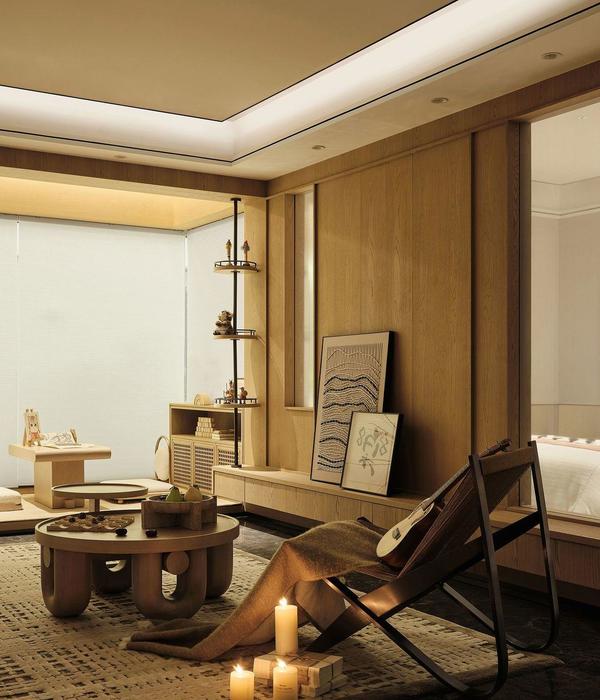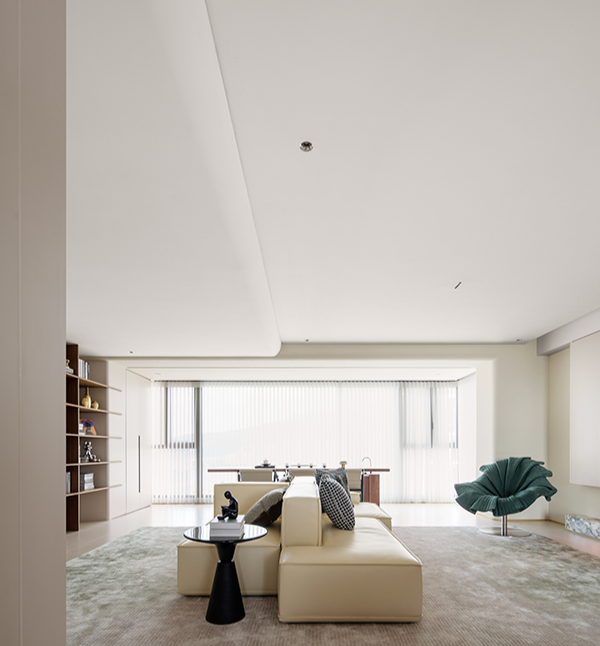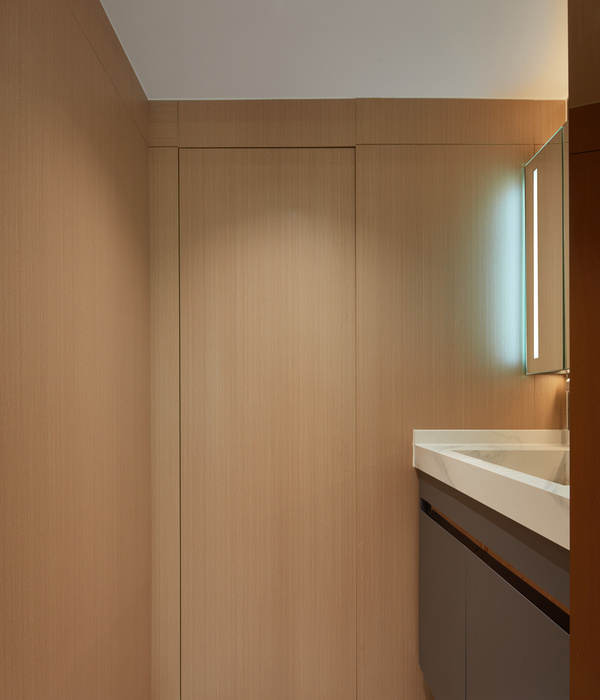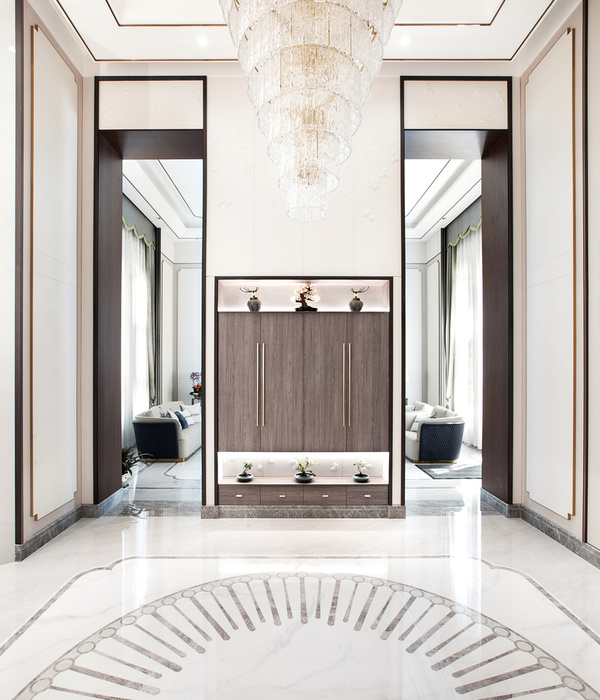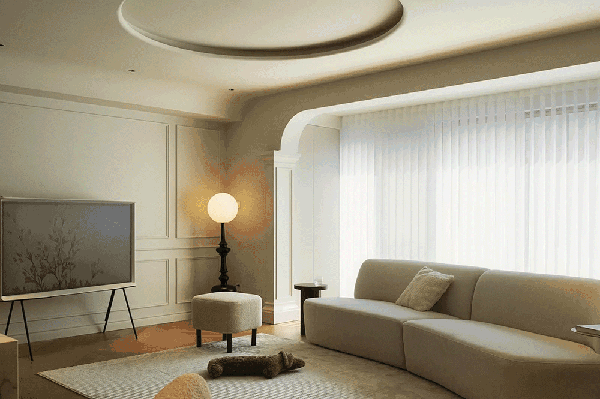该项目是三组住宅兼工作室的微密度建筑试验,它位于科尔多瓦市中心北郊杜卡斯街区的常规地块上,非常靠近苏基亚河和拉斯赫拉斯公园,这里曾经是销售车辆配件及相关用品的商业区域,如今正处在城市转型期。该建筑所在地块宽10米、长25.7米,是界墙之间典型的狭小地块。该项目基于没有堆叠放置、而是侧边相接的三个垂直单元,它们均可以前后通风并且带有集体车库、私人露台以及公共休闲露台。住宅实际宽度仅为3.3米,18米的纵向长度弥补了这一缺点。钢筋混凝土结构使房屋具有统一的表现形式和整体风格,因此这里通过楼层区分功能,不同楼层之间通过单元内从首层贯穿至露台的楼梯相连。空间的垂直性使内部无需隔墙,但也可以根据使用者需求或者随着家具增多而安装隔墙。
The building is a micro-density trial of 3 houses/studios paired, on a conventional lot in the Ducasse neighbourhood, on the northern outskirts of the central area of the city of Córdoba, very close to the Suquía River and Las Heras Park, a traditionally commercial sector linked to the sale of spare parts and supplies for vehicles of all kinds, which today is in the midst of urban transformation. The lot where the building is located is 10 m in front and 25.70 m in depth, that is to say, a small and typical neighbourhood plot between party walls. The typological concept of the project is based on three vertical houses, not stacked but attached to each other along their side boundaries, all with double ventilation, with collective garages, private patios and balconies and a terrace for communal recreation. The floors of the dwellings have a very small equivalent width of 3.13 m in their interior dimension, which is compensated by their large longitudinal development of 18 m. The reinforced concrete structure determines both the expression of the building and the typological character of the whole, so that the segregation of uses is given by the different levels linked by the stair system of each unit, from zero to the terrace. The verticality of the typology makes it possible to dispense with interior dividers, which will be installed, if necessary, at the request of the users’ needs, or with the incorporation of mobile equipment.
▼项目外观,external view © Arq. Gonzalo Viramonte
北立面采用镀锌编织网围合的金属结构,10米长的倒梁形成连续的钢筋混凝土箱体,从中生长而出的藤蔓攀附在金属结构表面。立面两侧界墙之间跨度为10米的倒梁允许2个主要隔墙有一部分不接触地面,从而腾出3个车库和大厅空间,在入口处形成开放空间。车被开走时,这里就成为居住者进行社交活动的空间。
The north façade is materialised with a metal structure enclosed with galvanised woven wire mesh, which is covered with deciduous vines, mainly wisteria, which grow out of a continuous reinforced concrete box, taking advantage of the inverted 10-metre-long beam of the façade. On the façade, an inverted beam with a span of 10 metres, from party wall to party wall, allows a sector of the 2 central partitions not to reach the ground, thus freeing up the space reserved for the 3 garages and the hall, creating an open space at the entrance; this space, when the vehicles are removed, becomes a space for sporadic social events for the inhabitants of the consortium.
▼北立面,north facade © Arq. Gonzalo Viramonte
▼局部立面,partial facade © Arq. Gonzalo Viramonte
▼入口,entrance © Arq. Gonzalo Viramonte
▼车库,garage © Arq. Gonzalo Viramonte
项目从剖面开始构思,其布局与传统房屋不同,学习/工作空间位于低层,与出入口和小庭院相连,其中庭院有时可以用作儿童游乐区或烧烤区。二层可以容纳两间卧室,但也可以根据使用需求用作办公室。三层是通高的,用于客厅、厨房和休闲空间,这里设有阳台和通往露台的通道,其中露台是公共庭院,享有城市中心天际线和西侧远山的美景。
▼剖轴测图,section axonometric © Mariela Marchisio + Cristián Nanzer + Germán Margherit
The project is conceived from the section, with an unusual layout for the logic of a conventional house, as the study/work space is located on the ground floor, in relation to the access to the building and to a small courtyard, which in some cases operates as a possible children’s play area or sporadic barbecue area; on the second level is the space for two possible en suite bedrooms, but also adaptable as a place of work if the modality of use should require it. On the third level, with double height, is the living, kitchen and leisure space, with balconies and access to the upper terrace, which serves as the common courtyard of the complex, with the incentive of the views of the urban skyline of the city centre and to the west, the remoteness of the sierras.
▼庭院鸟瞰,aerial view of the courtyard © Arq. Gonzalo Viramonte
▼多用途庭院,multipurpose courtyard © Arq. Gonzalo Viramonte
▼首层工作室,first floor studio © Arq. Gonzalo Viramonte
▼从工作室望向庭院,courtyard from studio © Arq. Gonzalo Viramonte
▼功能的灵活运用,flexible use of functions © Arq. Gonzalo Viramonte
▼儿童房入口,entrance of children’s room © Arq. Gonzalo Viramonte
▼儿童房,children’s room © Arq. Gonzalo Viramonte
▼主卧,master bedroom © Arq. Gonzalo Viramonte
▼二层可以根据需求用作办公室,the second floor can be used as an office as required © Arq. Gonzalo Viramonte
▼楼梯,staircase © Arq. Gonzalo Viramonte
▼三层休闲空间,third floor leisure space © Arq. Gonzalo Viramonte
▼阳台将阳光引入室内,the balcony brings sunlight into the room © Arq. Gonzalo Viramonte
▼通高空间,height space © Arq. Gonzalo Viramonte
▼客厅,living room © Arq. Gonzalo Viramonte
▼从客厅望向夹层,mezzanine from living room © Arq. Gonzalo Viramonte
▼夹层下的空间利用,space utilization under the mezzanine © Arq. Gonzalo Viramonte
▼夹层楼梯,staircase © Arq. Gonzalo Viramonte
▼通高的阅览区,reading area © Arq. Gonzalo Viramonte
▼餐厅,dining room © Arq. Gonzalo Viramonte
▼仰视通高空间,looking up to height space © Arq. Gonzalo Viramonte
这座建筑借鉴了日本案例,例如由岸和郎在东京设计的美丽房屋,但以南美视角呈现出别样的美。
A building that does not deny some revisited Japanese precedents, such as the beautiful houses of Waro Kishi in Tokyo, but translated with South American eyes.
▼室内夜景,interior by night © Arq. Gonzalo Viramonte
▼室外夜景,exterior by night © Arq. Gonzalo Viramonte
▼一层平面图,1F plan © Mariela Marchisio + Cristián Nanzer + Germán Margherit
▼二层平面图,2F plan © Mariela Marchisio + Cristián Nanzer + Germán Margherit
▼三层平面图,3F plan © Mariela Marchisio + Cristián Nanzer + Germán Margherit
▼立面图,elevation © Mariela Marchisio + Cristián Nanzer + Germán Margherit
▼剖面图,section © Mariela Marchisio + Cristián Nanzer + Germán Margherit
Project and technical direction: Arch. Mariela Marchisio – Arch. Cristián Nanzer – Arch. Germán Margherit Collaborator: Architect Marcos Barboza Year of project and execution: 2012 / 2014 Structural calculations: Ing. Edgard Morán Constructor: Adrián Molina / S. Heredia Aluminium carpentry: Aluvicor Elaborated concrete: Hormi – Block S. A. Blacksmiths: Fabián Aimar e Hijos / Luis Herrera & Diego Herrera / Surface area: 514.00m2 Photography : Arq. Gonzalo Viramonte
{{item.text_origin}}

